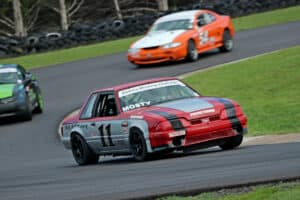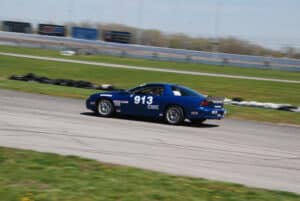
Everything You Wanted to Know About NASA's Camaro Mustang Challenge Racing Series
If you thought Camaros and Mustangs were strictly for stoplight derbies and quarter-mile racing, think again. Camaro-Mustang Challenge stages the timeless pony-car battle on road courses in your region. The rules are pretty buttoned down in terms of the modifications you can make, so there is no need for high-dollar engines, which keeps fields tight and costs in check. If you crave more track time, CMC cars fit nicely into Super Touring 4 classes and even E1 endurance classes.
1979-1995 Ford Mustang with 5.0 V8, including 1993-1995 Cobra (1993 and 1995 Cobra R models excluded)
1979-1986 Mercury Capri with 5.0 V8
1996-2004 Ford Mustang with 4.6 two-valve V8
1996-2004 Ford Mustang with 4.6 DOHC N/A V8 (2000 Cobra R and 2003-2004 Cobra models excluded)
1982-1992 Chevrolet Camaro (all submodels with V8 motors e.g. – RS, Z28 etc.)
1982-1992 Pontiac Firebird (all submodels with V8 motors e.g. Formula, Trans-Am, WS6 etc.)
1993-2002 Chevrolet Camaro (all F-Body models with LT1 or LS1)
1993-2002 Pontiac (all F-Body models with LT1 or LS1)
One option is to get a V6 car or bare tub for dirt cheap and powertrain swap. Pricing depends on your area, but listed below are some general figures for V8 manual cars.
Horsepower — 260-267 rwhp
Torque — 310-317 pound feet
Compression ratio — 10:1 compression for iron heads, 11:1 for aluminum heads
3,100 lbs. minimum for a 79-93 Mustang
3,150 lbs. minimum for 94-04 Mustang
3,250 lbs. minimum for non-LS1 Camaros and Firebirds
3,300 lbs. minimum for LS1 Camaros and Firebirds
Minimum weights increase if horsepower and torque exceed 260/310
Factory upgraded brakes (Mustang Cobra/C5 Corvette) or aftermarket upgraded brakes (Wilwood/Stoptech), race pads (i.e. Hawk DTC60/70), brake ducting, springs/shocks, alignment, poly/delrin/heim joints, 275/40/17 Toyo RA1/RR tires, 17 x 9-9.5-inch wheels, aftermarket radiators. Most stock GM engines need a restrictor to get down to legal power levels. The Ford 4.6 is allowed to run long-tube headers. The 5.0 can run shorty headers and the Ford Motorsports E cam with EFI, and a B cam with a carburetor. Basically, if the rules don’t state that an aftermarket part is allowed to be installed, then it’s not.
Average cost to run a weekend — $600 to $1,500 (depends on distance, practice, gas prices, tow vehicle economy, beer preference, etc.).
Tires, size, brand and prices
Toyo Proxes RR 275/40/17, $278 each
Toyo Proxes RA1 275/40/17, $273 each
Brakes, brands and prices
Pad costs vary depending on selected aftermarket caliper, between $120 and $400 a set. Some people run stock-style pads on the rear.
Stock-style rotors and some aftermarket options cost around $100 each. At the high end, two-piece rotor replacement rings can run $600.
Check the NASA Contingencies page for the latest programs.
Mid-Atlantic, Great Lakes/Midwest, Texas, and Rocky Mountain all have a consistently strong fields, with new drivers showing up every season.
Replacement parts are inexpensive and readily available. Because the cars use so many stock parts, a trip to any local parts store generally will get you back on track with very little, if any, missed track time, and only a small modification to your wallet. CMC drivers are notorious for lending a helping hand to fellow racers. Loaning parts and putting in the necessary hours to get someone back on track is another great quality of this close group of racers.
Convincing a Camaro/Mustang driver that there’s more to our cars than living life a quarter mile at a time. Rust Belt guys may have issues locating clean cars and used parts. It can be difficult to race a CMC car well. They are large and don’t handle the best. Compared with smaller cars or anything in GTS, they handle terribly. You cannot just point and shoot. On the other hand, this makes driving the cars on the edge highly entertaining and much more involved than cars where the throttle can be operated like an on-off switch. Then, of course, there’s the V8 noise! Keeping the cars and rule tweaks in line with the spirit of CMC, while balancing the benefits of modifications and aftermarket parts and their perceived or real costs.
Another challenge is convincing the HPDE3 or 4 driver to stop tracking the newer Camaro or Mustang making more than 400 horsepower and go to 260 whp and older technology. The reality is that you are putting fewer dollars at risk and are safer in a caged racecar.
All participants who wish to compile season points must have a dynamometer certification report prior to the start of the race or make arrangements to have a dyno test performed immediately after the race. If a dyno test is performed after the race, the hood will be sealed and other measures may be taken to ensure no changes are able to be made to the car that would alter its power output.
Any rear spoiler/wing that fits the following criteria may be used:
No carbon fiber doors or lightweight panels. CMC requires all factory or equivalent body panels.
A section of the floor may be cut, and a trap door added, to enable changing the in-tank fuel pump without removing the tank.
The battery may be relocated. The battery must be of the same type, group size (i.e. 24F), and voltage as originally equipped, or heavier, and may not be modified.
All cars must use OEM stock exhaust manifolds with the following exceptions:
Any gear ratio equal to or numerically lower than 4.11 that fits the stock/alternate differential case without modification may be used. Differentials may be fully locked (welded) or use any commercially available mechanical limited slip.
Engine balancing is allowed. Lightening of parts beyond the minimum required to balance is prohibited. Boring/honing is allowed up to 0.060 over. Head/block milling is allowed, but only as far as required to square/clean the surface area.
Springs of any rate, OD, ID and free length may be used. Springs must install in the OEM stock unmodified location using the original system of attachment unless noted elsewhere in these rules.
Unlike other spec classes, the CMC rules have limits on the engine parts you can use and limits on horsepower and torque. With both these constraints in place, you are restricted on how much money you can spend. The idea is that you are not looking for the lightest stock pistons or best flowing stock head, because you are only allowed to make 260 to 267 horsepower.
Camaro Mustang Challenge Resources
Questions and Answers to Feed Your Curiosity
There are several items that distinguish CMC from AI.
1) American Iron is a class based on power-to-weight ratios. CMC has a specific HP and minimum weight.
2) CMC does not allow any aftermarket body panels or glass. You must run all stock fenders, doors and glass.
3) CMC is limited to Mustangs from 1979-2004 and Camaros and Firebirds from 1982-2002. AI allows any American made sedan from 1960 to present front engine and rear-wheel drive.
4) CMC is exponentially cheaper than AI. Figure $10-20k to build a CMC car that can win at the NASA Championships, and closer to six figures depending on your ability to fabricate to win the Championships for AI.
Compare and contrast the rules at https://members.drivenasa.com/rules.
Yes, but arm restraints must be used unless permanently fixed panels have been installed.
The only hot setup is in the mind of the owner. CMC cars are evenly matched, and the directors strive year after year to make sure one platform does not have a significant advantage over the other. The Ford camp thinks the GM camp has an advantage, and vice versa.
Competition is close in CMC because the platforms are so evenly matched. Properly prepared CMC cars will generally run within 2 seconds a lap of one another on any given weekend.
CMC is most popular in the Texas, Rocky Mountain, Great Lakes and Mid-Atlantic regions, and we are hoping to grow the class in other regions without CMC competitors.
One of the best features of CMC is parts availability. Since the cars are close to stock, if you break something, usually the replacement part is no farther away than your local auto parts store. As for the racing parts, there are a number of good places to get off-the-shelf items like heim joints, dampers, sway bars, upgraded brakes, etc. There’s nothing exotic or custom about the equipment on these cars.
Yes, with a minimum weight of 3,300 pounds for aluminum block and 3,250 for iron block LS engines.
Yes, you can run a rear wing with some restrictions (see rules). But CMC does not allow any front aero, only a small air dam for cooling purposes, so rear wings generally do too much, cause a push condition, and are difficult to sort out. Competitors are generally better off with a smaller lip spoiler.
No, this is currently not legal for CMC. There are spec carbureted setups laid out in the rules for Ford and Chevy that will get the cars to the power to weight necessary and still be reliable for far less money than a bolt-on EFI system.
No, each model has some vulnerabilities and the directors take priority each rule season to make sure the rules address reliability issues. For example, the fourth-generation Camaros have issues with stock front hubs, and we accepted an aftermarket solution to allow the use of a traditional hub with a tapered roller bearing. We are also now offering a solution to replace the GM Optispark ignition systems on the LT1 cars. Certain Fords are allowed to run stronger aftermarket crankshafts, and the rear control arm bushings are a maintenance item.
This depends on the spirit of the owner. Some want to build a car so they know what they have and some prefer to buy and save time and money. One thing to watch out for when buying a built car is the quality of the build. They’re not always going to be up to your standards, so you may not save as much time as you think.
No, these cars are at the bottom of the depreciation cycle and are everywhere on Facebook Marketplace, Craigslist, Auto trader, etc.
Latest Camaro Mustang Challenge News Around The Country
Wouldn’t it be great if there were a NASA contingency and Member Benefits partner that offered rewards and discounts on hardcore racing parts we […]
As NASA’s official tire retailer, TrackDayTire.com gives NASA members immediate access to an extensive national inventory of Toyo and Hoosier DOT R […]
The stakes are high in Turn 1 on lap one. That’s true of regional events and certainly at the NASA Championships. For this week’s Yokohama Move […]
The 2023 NASA Championships were the culmination of hard work and sacrifice for the drivers who came from across the United States to compete at the […]
Every year we put out a list of drivers favored to win the NASA Championships and every year we get a lot of it wrong. But this year feels different. […]
What Camaro Mustang Challenge Competitors Say




Get On-Board with Camaro Mustang Challenge Drivers
Camaro Mustang Challenge Series Contacts